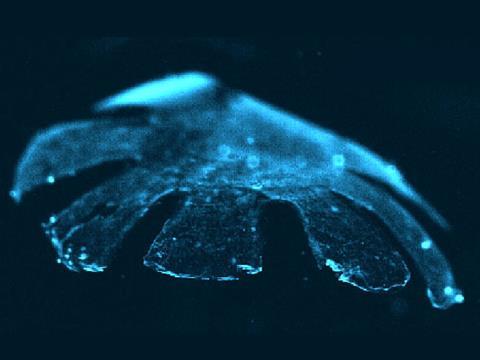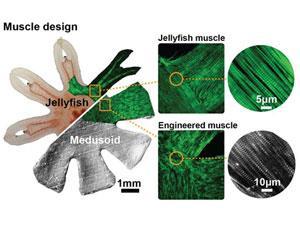
It may sound like the plot of a low-budget movie, but US scientists have created tiny, half-biological, half-synthetic jellyfish that can swim and even feed just like real jellyfish. And far from terrorising innocent civilians, these cyborg jellyfish could be put to good use testing novel heart drugs.
Inspired by a juvenile stage of the jellyfish Aurelia aurita, the cyborg jellyfish are around 18mm in diameter and consist of a flat disc of silicone polymer with eight surrounding wedge-shaped lobes. Onto one side of the disc and lobes are coated heart muscle cells from a rat. (You can watch a video of the team explaining how they created the cyborg jellyfish here)
When placed in salt water and exposed to a fluctuating electrical field, the heart muscle cells contract, forcing the lobes downwards and driving the jellyfish forwards. As the heart cells relax, the lobes naturally recoil back to their original position, ready for another contraction (video).
To work properly, however, the coating of heart muscle cells needs to replicate the precise pattern of muscle cells found in A. aurita. ‘We used an algorithm commonly used by law enforcement agencies to quantify fingerprints to analyse the subcellular protein structures of the muscle cells [and] made a map of where every muscle cell in the jellyfish was,’ explains team leader Kit Parker from Harvard University. They then used this map to guide the coating of rat muscle cells onto the polymer.

The resultant cyborg jellyfish were able to swim just as fast as juvenile A. aurita and could also replicate their feeding mechanism, whereby the recoiling of the lobes drives water and any potential food in that water, up into the jellyfish body.
As well as being the first of a new breed of cyborg, the pumping action of the jellyfish means they could also form the basis for a new breed of artificial hearts. Already, Parker and his colleagues are looking at the possibility of using the jellyfish to test novel heart drugs. ‘If drugs are designed to improve the pumping of the sick heart, mimicking the pumping of the sick heart on this jellyfish gives us a much better technique to judge the efficacy of the drug than current methods employed in the pharmaceutical industry,’ he tells Chemistry World.
Robert Langer at the Massachusetts Institute of Technology, US, is impressed with the cyborg jellyfish. ‘Looks very neat to me,’ he says, although he’s not sure yet whether they have any implications for his own tissue engineering research.
But they could merely be the first generation. Parker is now looking to create more advanced versions that are able to move in a particular direction and even respond to their environment, as well as using the same approach to create other cyborgs.
References
- J C Nawroth et al, Nat. Biotechnol., 2012, DOI: 10.1038/nbt.2269






No comments yet